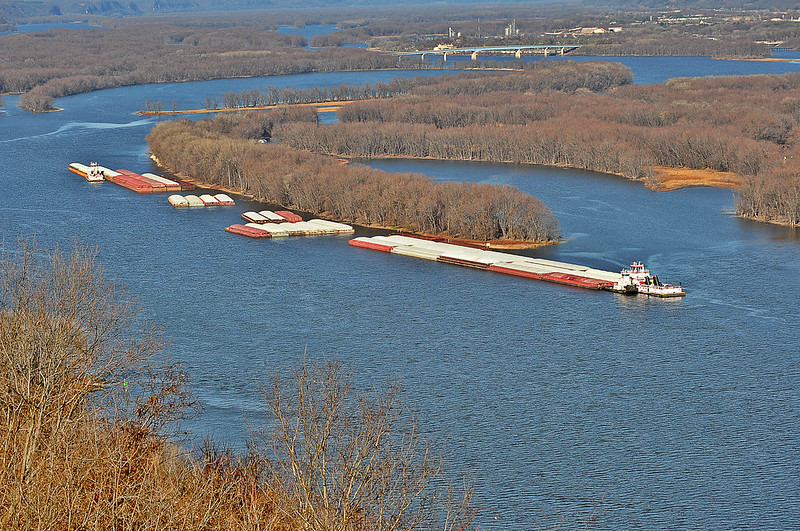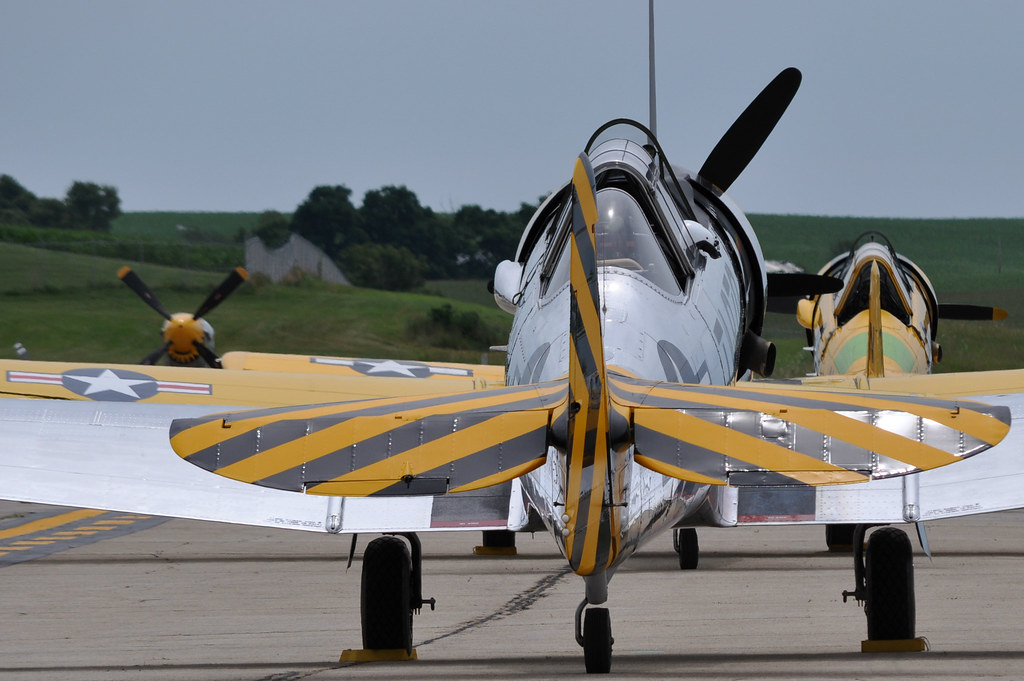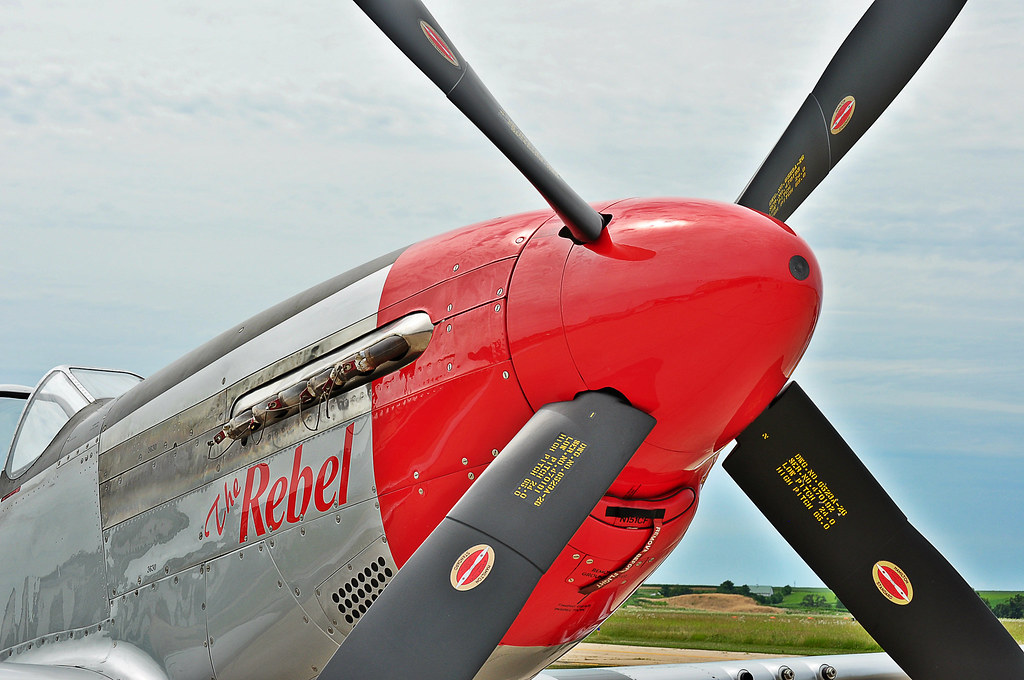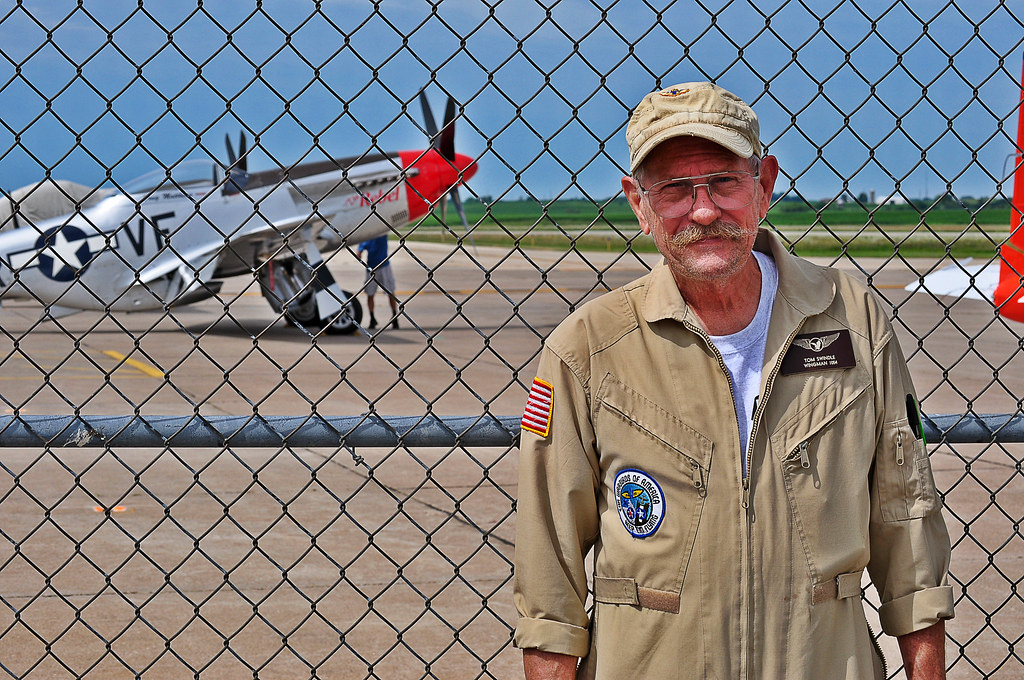Showing posts with label Wisconsin. Show all posts
Showing posts with label Wisconsin. Show all posts
Monday, September 3, 2018
T-6 Awaits for AirVenture 2018 Landing Slot
At the Dubuque, Iowa airport (DBQ) a vintage T-6 waits for the landing slot at AirVenture Oshkosh 2018 on July 22nd. Annually, the North American Trainer Association (NATA), made up of T-6 pilots and owners, gather in Dubuque for association business and to practice takeoffs/landings and formation flying for EAA's Airventure in nearby Wisconsin. WWII-era T-6 planes from around the world come to Dubuque for the meeting and are occasionally accompanied by a few P-51 Mustangs and F-4U Corsairs. Watching and listening to the planes as they roar to life, circle overhead and trail smoke in various formations is well worth the trip to Dubuque. The event inside the hangers and on the tarmac is not open to the public except for viewing behind fences. Be sure to stick around after the T-6s takeoff for Airventure - a few minutes later the planes will be in formation, trail smoke and give Dubuque an aerial salute before traveling east over the Mississippi River.
Labels:
DBQ,
Dubuque Regional Airport,
iowa,
NATA,
North American,
OSH18,
Oshkosh,
summer,
T-6,
WI,
Wisconsin,
WWII,
WWII aircraft
Sunday, July 24, 2016
Corsair Readies at Dubuque Regional Airport Prior to OSH16
This afternoon a World War II vintage Corsair sat at the Dubuque Regional Airport prior to traveling to Oshkosh for the EAA Airventure 2016 event. For the past 11 years WWII planes have staged at Dubuque while waiting for landing slots at the Wisconsin event. More the a million people are expected to attend OSH16. If you can't make it to OSH be sure to visit DBQ a day or two ahead of Airventure next year to see a segment of the flying entertainment.
Wednesday, November 18, 2015
Mid-November Tug Traffic on the Mississippi River
On November 15th the temperatures along the Iowa - Wisconsin border were near 60F. Tugs and barges took advantage of the weather to move northward on the Mississippi River towards Prairie du Chien, Wisconsin (upper left.)
A small tug pulled along side of the David L Griggs tug. Both vessels belong to the Marquette Transportation Company which operate from Paducah, Kentucky on the Ohio River. David L Grigg's present location can be seen at this link.
The smaller tug detached from the Griggs, rotated and helped to push a formation of barges just outside of the frame.
Another tug was busy assembling the formation just north of the smaller tug and the DLG. This island, which is visible from Iowa's Pike Peak State Park is probably a staging area for barges as there is evidence of tie offs and signs.
Monday, July 20, 2015
Some Impressions From the T-6 Trainer Association Gathering at Dubuque Regional Airport
The T-6 Trainer Association meets the weekend of the start of EAA's Oshkosh air spectacular, The T-6 Texans stag at the Dubuque Regional Airport for a private gathering where the pilots practice two by two take offs and formation drills. This year I was able to visit the planes from both sides of the fence with the help of some event organizers. This photo is of a spotless T-6 that sports a chrome and paint look. I thought the contrast of metal and paint made for a great composition. Note the Iowa backdrop.
Two P-51 Mustangs were also present on the tarmac. The Rebel was cleaned before its flight to Wisconsin. I'm guessing that the cost to purchase this would be a couple of millions of dollars if it were on the market. Who knows what it costs to maintain it?
I met Tom Swindle from the Fort Worth, Texas area. Tom watched his pilot buddy fly a T-6 earlier in the day. Tom works at Cowtown Aerocrafters where WWII era aircraft are restored and maintained.
This is usually my vantage point to see the Oshkosh bound WWII planes. Sometimes I can get the lens through the chain link fence or in between the gate door. This year was a bit different.
Friday, April 18, 2014
US Grant Watches Traffic from Cuba City
 Take a ride to southwestern Wisconsin and you'll drive through Cuba City. Many of the streets are named after US presidents including a president from the next door county in Illinois, US Grant. His portrait is painted on a the south facing side of a caboose overlooking main street.The rail car is actually a city museum and an information center for the area. The city's former rail depot is located across the street from this display but is difficult to recognize with all of its structural modifications.
Take a ride to southwestern Wisconsin and you'll drive through Cuba City. Many of the streets are named after US presidents including a president from the next door county in Illinois, US Grant. His portrait is painted on a the south facing side of a caboose overlooking main street.The rail car is actually a city museum and an information center for the area. The city's former rail depot is located across the street from this display but is difficult to recognize with all of its structural modifications.Monday, May 20, 2013
Howitzer "Guards" Lock & Dam 10 at Guttenberg, Iowa
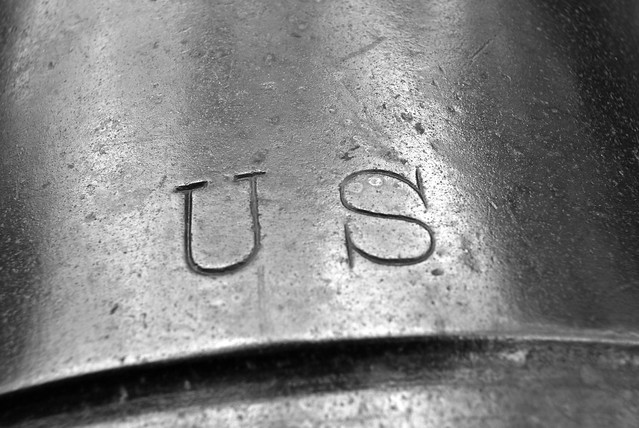 Guttenberg, Iowa is a scenic small town located in northeast Iowa along the Mississippi River. Among the many sites of the historic town is the relatively new veteran's memorial and cannon display. Yesterday as the 42N team took some of the scenic highways to and from Iowa's driftless area, a stop at Lock & Dam No. 10 produced an opportunity to perform a quick photo study of a Civil War era cannon.
Guttenberg, Iowa is a scenic small town located in northeast Iowa along the Mississippi River. Among the many sites of the historic town is the relatively new veteran's memorial and cannon display. Yesterday as the 42N team took some of the scenic highways to and from Iowa's driftless area, a stop at Lock & Dam No. 10 produced an opportunity to perform a quick photo study of a Civil War era cannon. From the markings on the cannon I discovered this is a 24-pounder flank howitzer. The foundry that made this cannon in South Boston, Mass. produced 577 of these heavy fellows, of which some 269 survive. This particular cannon was produced in 1863.
Guttenberg's old time cannon is situated perpendicular to the river and is aimed at Wisconsin. But don't worry Badger fans. Given the altitude of the barrel there is no chance that even a fully charged cannon ball would fly past the state line located at mid-river. Since this is an inactive cannon (for display only as part of the veteran's memorial) the purpose of the hardware is to remind people of the epic struggle fought by area soldiers and sailors a hundred and fifty years ago.
Labels:
cannon,
Guttenberg,
history,
howitzer,
iowa,
Lock and Dam 10,
Wisconsin
Saturday, December 15, 2012
Black Hawk War Era Fort Stands at Sinsinawa Mound
You usually don’t associate the word “fort” with the American
Midwest, let alone the upper Midwest . Sure
they exist, even in Iowa ; places like Fort Madison ,
Fort Atkinson
and Fort Dodge .
These fortified structures provided a place of safety, collection of a garrison
and exerted regional control over the expanding territory as the United States
pushed over the continent.
 We learn about the major events in our country’s history in
school but rarely does the material detail the
We learn about the major events in our country’s history in
school but rarely does the material detail the
So it’s little wonder that while traveling just outside of Iowa near Sinsinawa , Wisconsin (an unincorporated community just a few miles
east of Dubuque , Iowa
Extreme southwest Wisconsin
consists of rolling prairie hills. Prominent at Sinsinawa is a conical hill
that dramatically rises off the landscape and is topped off by a crown of
trees.
Early settlers farmed and raised livestock in the area –
much like the practices today. Lead was mined and smelted on the mound. When Sac (Sauk) and Fox factions threatened the well being of settlers a fort was constructed.
Local resident, later one of the first two Iowa Senators, George Wallace Jones
built this structure.
A display sign at the fort reads, “In the spring of 1832, at
the outbreak of the Black Hawk War, I built a log fort or block house for the
protection of my family…and neighbors.”
While I have not fully investigated the stone structure, it
is obvious that the building was recently preserved with concrete flooring and
column supports. The interior displays old lead mining equipment.
I have marked this as a subject to more fully explore. To
make it even more fascinating is the fort’s assimilation with the buildings of the
Sinsinawa Dominican Congregation of the Most Holy Rosary. The site is motherhouse
for 600 sisters who conduct educational training and spiritual relationships –
just steps outside the fort.
Thursday, December 6, 2012
Controlled Burn at Farm House Near Sandy Hook, WI
A controlled fire southeast of Sandy Hook, Wisconsin brought in several area fire departments in addition to people investigating the tower of smoke. The home was purposely set on fire while crews practiced various spraying methods of containment, then allowed the structure to completely burn. A portion of the second story of the old farmhouse can be seen falling on the left. This is yet another example of keeping a camera with you especially as you tour the 42N latitude.
Sunday, December 2, 2012
UFO Landed in Sinsinawa's Valley of the Dinosaurs
 Travel over the Highway 151 bridge from
Travel over the Highway 151 bridge from  Continue east of the mound about a mile and you will notice
a slight rise of a hill on the highway. As you crest the hill (still east
bound) you will plunge into an alien world of dinosaurs and an UFO. There’s
about eight metal dino sculptures in a pasture greeting you
unexpectedly. New to this mixture of creatures is this UFO craft
complete with a green faced alien at the controls.
Continue east of the mound about a mile and you will notice
a slight rise of a hill on the highway. As you crest the hill (still east
bound) you will plunge into an alien world of dinosaurs and an UFO. There’s
about eight metal dino sculptures in a pasture greeting you
unexpectedly. New to this mixture of creatures is this UFO craft
complete with a green faced alien at the controls.
While photographing these objects of art I parked along the
shoulder of the busy highway. I walked outside of the guard rail to
get closer to the dinosaurs. Not surprisingly the ground was littered with discarded containers of energy drinks, beer, fast food wrappers, and
miscellaneous plastics, broken glass and paper. Oddly no cheese wrappers were
found despite being within a few miles of curd central, Shullsburg. Friendly
Wisconsinites even blew their horns as if I cared to look at them zipping by at 55 mph rather than observing the herd from Jurassic
Park
Wednesday, June 20, 2012
You Can Get Anything You Want At Prairie Du Chien's Flea Market
Rendezvous time at Villa Louis in Prairie du Chien, Wisconsin brings it all out; buck skinners, frontiersmen, soldiers, natives and tons of spectators. You can watch demonstrations of frontier life from back in the 1700s. You may also buy things from people dressed in puffy shirts, coonskin hats and loin cloths. Beware; there are some sights to be avoided if you want to keep your eyes intact. Mine are still recovering from the solar eclipse from a few weeks ago.
 Outside of the Rendezvous parameter are scores of flea market vendors from all over the country. They sell pretty much anything you want - food, drinks, clothes, books, antiques, records, car parts, jewelry, and even gator heads. Many vendors tell stories of how they got into this business first as collectors then later as dealers.
Outside of the Rendezvous parameter are scores of flea market vendors from all over the country. They sell pretty much anything you want - food, drinks, clothes, books, antiques, records, car parts, jewelry, and even gator heads. Many vendors tell stories of how they got into this business first as collectors then later as dealers.
Bearded hat guy watched over his eight tables filled with small antique and collectible items. His choice of truck was a gray hearse. He talked of being able to pack a lot inside the long vehicle which was
purchased cheap. Over the three day flea market period he slept outside on the
ground. In the mornings the hardness of the dry ground bothered his back. He
thought about sleeping in the hearse during his last night there.
Sunday, April 10, 2011
Glancing Potential of a 1937 Chevy Pickup Truck
A 42N area owner of a 1937 Chevrolet pickup truck looks through the passenger window of his prize possession explaining why his investment hasn't been realized. He has dreams of restoring the half-ton vehicle to show worthy status someday. But that day has not yet materialized.
The truck was been kept indoors for several years after he purchased it over a decade ago. Things changed when the building owner notified him about the property being sold so he had to vacate the storage area.
Since then the 74-year old antique makes its home outdoors next to its owner's garage, exposed to the elements and various gnawing rodents. While this Chevy has much of its original equipment, the toll of time means things need attention like the windshield, the engine, the door frame, and the fill in the blank several times here.
The owner received many estimates from professional and hobbyist restorers who concur as to the price of transforming his pickup into a quality showoff vehicle. By several estimates the price to dial this baby up could exceed the potential sale price for a 1937 vehicle in tip-top restored condition. That is one reason why this owner hasn't restored yet.
 But the real reason this truck has not been brought into the flashiness of the twenty-first century was something more pressing - his child's education. Our pickup owner and his wife saved their income to help offset college expenses for their daughter rather than restore the truck. Their daughter has since graduated, moved away and is employed as a nurse in Wisconsin.
But the real reason this truck has not been brought into the flashiness of the twenty-first century was something more pressing - his child's education. Our pickup owner and his wife saved their income to help offset college expenses for their daughter rather than restore the truck. Their daughter has since graduated, moved away and is employed as a nurse in Wisconsin. A neighbor recently offered an indoor storage option for the pickup just a few blocks away. The owner thinks that he will place his early pickup in storage while considering ways to bring the '37 Chevy back to life. His goal is to someday drive the restored pickup to visit his daughter in Wisconsin - and make it back to Iowa without falling a part. Know that.
Sunday, July 25, 2010
Why a Potosi Coca-Cola Cooler Just Needs a Bit of Work
Summertime in mid-America means outdoor auctions. And auctions mean almost everything is available to buyers - for the right price. Recently in 42N's Potosi, Wisconsin, an item became available for the serious restorer. A rusty Coca-Cola refrigerated cooler frame was for sale complete with only what you see here - four walls and floor.
While some of these coolers sell for around $800 when restored, the Potosi frame will take a bit of work but it has potential. I found this competed cooler photo here. The bottle opener seen in the upper right hand corner of the complete unit compares to the rusty unit's post foundations.
I didn't stay to see the rusty frame sell but it probably wasn't much more than a hundred dollars judging on how other transactions were completed that day. While it would be cool (no pun intended) to have a fully restored cooler for your bottled cola, my preference is Pepsi, the chief rival product of Coke. Know that.
Tuesday, June 30, 2009
New Amish Arrivals in Wisconsin
.JPG) A lone Amish buggy trots near Platteville, Wisconsin on Father's Day 2009. Since the year 2000 hundreds of Amish families have moved from Pennsylvania to southwest Wisconsin. The main reasons seem to be the much lower price of farm land and the lure of rural settings of the Midwest - away from the growing metro centers in the East. On this day a young man in black, duster-like rain gear navigates the rolling prairie, passing other wet Amish-worked fields. Know that.
A lone Amish buggy trots near Platteville, Wisconsin on Father's Day 2009. Since the year 2000 hundreds of Amish families have moved from Pennsylvania to southwest Wisconsin. The main reasons seem to be the much lower price of farm land and the lure of rural settings of the Midwest - away from the growing metro centers in the East. On this day a young man in black, duster-like rain gear navigates the rolling prairie, passing other wet Amish-worked fields. Know that.
Sunday, June 21, 2009
Climbing Platteville, Wisconsin's Mighty M


Just to the east of Platteville, Wisconsin is a rise of land off the prairie with a gigantic white "M" on it, facing to the west. You can see it for miles, in fact you can see it from Wisconsin, Iowa and Illinois. After several trips past the 241 foot tall M over the years we decided to get closer and snap a few photos.
At the base of the whitewashed stone and concrete M completed by students in 1937 from the nearby University of Wisconsin-Platteville, School of Mines (mining is no longer offered at the school) is a picnic table and a set of stairs leading to the top of the hill. After climbing 266 named-stairs by financial donors you can see the midwestern prairie stretching for miles. If you take your time - and an oxygen tank - you can climb the stairs stopping at three lookout posts along the way. Consider the lookouts as basecamps. At the top of the climb is a large platform for scenery viewing including a freestanding set of binoculars (no charge to view through it.)
The best part of the journey up is the outstanding view of the rolling country side. To the south is Amish country where you can see horse and buggies and well-kept farms. To the west is Platteville. Ironically you cannot readily see the M once you are on top of the hill (see photo above.) The other best part of the journey up is the much easier descent. Know that.
At the base of the whitewashed stone and concrete M completed by students in 1937 from the nearby University of Wisconsin-Platteville, School of Mines (mining is no longer offered at the school) is a picnic table and a set of stairs leading to the top of the hill. After climbing 266 named-stairs by financial donors you can see the midwestern prairie stretching for miles. If you take your time - and an oxygen tank - you can climb the stairs stopping at three lookout posts along the way. Consider the lookouts as basecamps. At the top of the climb is a large platform for scenery viewing including a freestanding set of binoculars (no charge to view through it.)
The best part of the journey up is the outstanding view of the rolling country side. To the south is Amish country where you can see horse and buggies and well-kept farms. To the west is Platteville. Ironically you cannot readily see the M once you are on top of the hill (see photo above.) The other best part of the journey up is the much easier descent. Know that.
Friday, December 19, 2008
Farewell S.S. Badger

The S.S. Badger leaves her Ludington, Michigan port for Manitowoc, Wisconsin. As the only coal-fired steamship in operation in North America, the 410 foot S.S. Badger ferries passengers and autos across Lake Michigan daily during the open water season. On this August day in 2007, the S.S. Badger passes the breakwater at Ludington where people gather to fish and gaze at the lighthouse and harbor. During the summer the Badger departs Ludington at 7:55 pm ET.
Subscribe to:
Posts (Atom)



